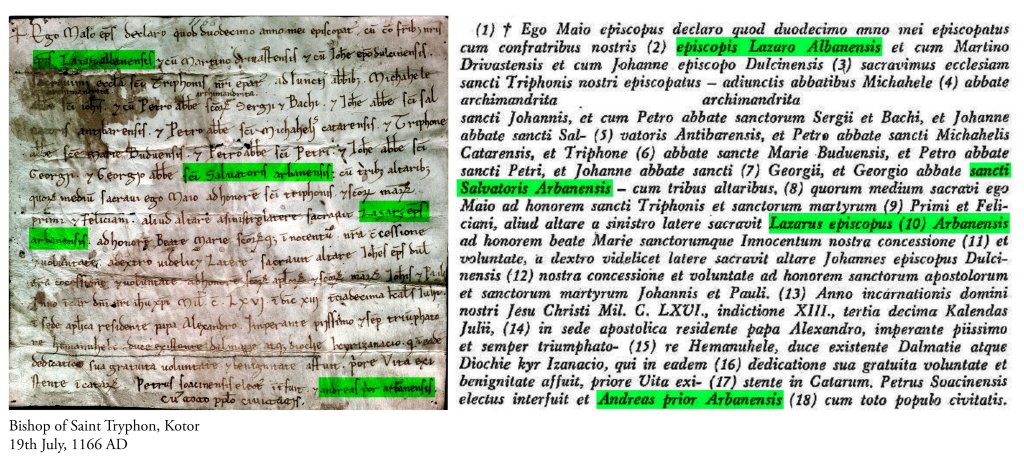
“In a document dating from 1166 AD, we find a “Episcopis Lazaro Arbanensis” and a “Andreas prior Arbanensis.” The title “prior” indicates regional autonomy, and a head bishop means a Diocese of Arbanon with defined borders already existed in 1166 AD.”
Albanian Petrana family and Durrës Theodorus de Petronia of the 13th century
Pjetër Durrësaku of 1326
“Whereas, the well-known merchant, Pjetër Durrësaku, on 16. XII. 1326
entered into an association of a merchant from Popovo polje and three
Albanian merchants, Georgius Arbanese, Stanusius (Tanusius-ver. J.
D.) Arbanese and Prodanus Arbanese. We also met Pjetri in another
association registered in the Ragusan office. In these trade associations,
there were also occasions to meet some traders from Kosovo. Here, one
must cook ngoja niäforä Bali nas Noughärda igili in 1457 dononai miota in a … “1
“… to the early Ragusan family Potragna, Petrana. The first part of this
Marinus de Petrane family and his son Georgius we met in Ragusa
during the years 1219-1253, respectively during the years 1253-1280. Almost in it at the same time, namely in 1215, we meet something in Durrës Theodorus de Petronia and his son Georgius, as well as over the years 1219-1235 some presb. Petrana filius Theodorii, who was probably … “2
Albanian lord and prince Dhimitri of 1210
” … their wealth. It should be noted that in addition to the privileges enjoyed by some Albanian lords and benefactors in Ragusa, the people of Ragusa often enjoyed special benefits from the Albanian lords, such as, by the way, from prince Dhimitri (year 1210) … “3
Aleks Durrësaku of 1331
“These trade associations were founded in order to pool financial
means, to reduce the risk during travel, to earn more easily. At
least two or more traders are united in trade associations. As
members of trade associations, we meet a considerable number of
Albanian traders. Thus, on 25.XI. 1331, in an association of six
people, among them was the Albanian merchant Aleks Durrësaku.”4
Mikel Durrësaku of 1328, Master Bernard in 1330, Mençe Durrësaku and Isak Durrësaku, as well as Gjergj Durrësaku, Gjon Durrësaku and Nikollë Durrësaku and Fani …
” … apart from the results of the French researcher A. Ducellier, the number of Albanians with this quality in Ragusa is quite present. Thus, in this capacity we can also mention Pjetër Durrësak (in March 1326), 11
Mikel Durrësak (May 1328), 12 master Bernard (April 1330), Mençe
Durrësak, 13 Aleks Durrësak (21. III. 1349), 14 Isak Durrësakun (January
1374), Gjergj Durrësakun, Gjon Durrësakun, Nikollë Durrësakun, Frani, … “5
Mikel Durrësaku in 1329 and Nikollë Durrësaku
“in 1329 in his shop, Mikeli hired the son of a certain Radomillus from
Junketa for a period of 8 years. In the 30s of the century. XIV
in Ragusa we also meet a tailor from Durrës, who was undoubtedly
much richer than Michael, it is Nicoletus sartor de Durachio, who in
1333, after having lent something to Schimus from Lezha, declares
that, if doesn’t pay back the debt, he will sell the things Minalatoni
had left Miuiti 1336 … “6
Gjergj Arbëreshi
” … Whereas, in 1328, he had a house, which he sold to a certain
Zagrebian named Ivan. In this year, we find this mentioned again
in a document, from which we learn that he also owned a house in
Ragusa, which he mortgaged to Gjergj Arbëreshi. These two
cases mentioned above clearly show that Mikel went into debt to secure
the raw material. However, he managed to pay his debts.”7
The Ronçino family of Ulqinn
” … a member of the Ulcinian Roncino family, Nicola filius Bubagna de Roncino, de Dulcigno received the right of Ragusan citizenship. He and his brother Michael were related to generous families from Ragusa. However, they did not manage to be included in the councils of the Ragusa government. In addition to the Rončino family, which is identified with an early family from Ragusa, we have an almost identical example in the case of … “8
Nicolo de Manuelo de Duraco (1311), Grube de Cari de Antibaro (1319), Georgius Syme Chozani de Dolcigno (1350), magister Nichola Chalagarius, p Vitani de Schtari (1350), Vasilius Zenosi de Ualona (1357) and Thomasius Domenici Arbanensis (1360)
“… in this capacity we also meet people from the territory inhabited by Albanians. In this case we will mention only a few: Nicolo de Manuelo de Duraço (on 11. XII. 1311), Grube de Çari de Antibaro (on 17. VI. 1319), Georgius f, Syme Chozani de Dolcigno (2. V. 1350), magister
Nichola chalagarius, p. Vitani de Schutari (2. V. 1350), Vasilius Zenosi de
Ualona (15. IV. 1357), Thomasius Domenici arbanensis (5. V. 1360) … “9
Albanians Saruba of Ulqin in 1313 and Strepaza of Shkodër in 1319
“1313); In origin Rekuš; Schuba (Saruba) of Dolzigno of Albania (1313);
Still (Still) of Scutari (fundi i shek. XIV); Strepaza (Stepaza) of Scutari
(estinti) 1319. A document founded by the sheikh. XII; Spavo
(Spavaldo) of Antivary of Albania (estinti) 1310; Sorghum di Cataro, de Redoni d’Albania ancient 1272; Valchacello of Scutari (1313); Vecesti (Veresti) of Scutari (13th century): Virgo of Scutari (estinti) 1310.22 The road … “10
Giorçius Arbanese in 1320 and his brother Gianni
“… Arbanese “have a boat in company. (Ib.) (1320), January 13, “Giorçius Arbanese and his brother Gianni” having a boat are in company with some others. (Ib.) – 1323, August 15. Life of Arbanese and his Menega…”11
Albanian Dum Sargi (Dum Sàrg) (Domë Shargi?), friend of Stjepan of Bosnia12
References
- https://www.google.se/books/edition/Gjurmime_albanologjike/GaTiAAAAMAAJhl=en&gbpv=1&bsq=Arbanese&dq=Arbanese&printsec=frontcover ↩︎
- imbid. p.50 ↩︎
- imbid. p. 44 ↩︎
- imbid p. 56 ↩︎
- imbid. p. 41 ↩︎
- imbid. p. 54 ↩︎
- imbid. p. 54 ↩︎
- imbid. p. 48 ↩︎
- imbid. p. 41 ↩︎
- imbid. p. 42 ↩︎
- https://www.google.se/books/edition/Acta_et_diplomata_res_Albaniae_mediae_ae/7xY3AQAAMAAJ?hl=en&gbpv=1&bsq=Arbanese&dq=Arbanese&printsec=frontcover ↩︎
- https://www.google.se/books/edition/Zapiski/-MJHAQAAMAAJ?hl=en&gbpv=1&dq=arbanese+Dum+S%C3%A0rg&pg=RA1-PA313&printsec=frontcover ↩︎